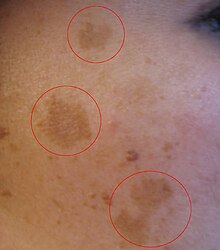Melasma
| Melasma | |
|---|---|
 | |
| Specialty | Dermatology |
Melasma (also known as chloasma faciei,
Signs and symptoms
The symptoms of melasma are dark, irregular, well-demarcated, hyperpigmented macules to patches. These patches often develop gradually over time. Melasma does not cause any other symptoms beyond the cosmetic discoloration.[4] Patches can vary in size from 0.5 cm to larger than 10 cm depending on the person. Its location can be categorized as centrofacial, malar, or mandibular. The most common is centrofacial, in which patches appear on the cheeks, nose, upper lip, forehead, and chin. The mandibular category accounts for patches on the bilateral rami, while the malar location accounts for patches only on the nose and cheeks.[5]
Cause
The exact cause of melasma is unknown.[6]
Melasma is thought to be the stimulation of
Pregnant women often get melasma, or chloasma, known as the mask of pregnancy. Birth-control pills and hormone replacement therapy also can trigger melasma. The discoloration usually disappears spontaneously over a period of several months after giving birth or stopping the oral contraceptives or hormone treatment.[3]
Genetic predisposition is also a major factor in determining whether someone will develop melasma. People with the Fitzpatrick skin type III or greater from African, Asian, or Hispanic descent are at a much higher risk than others.[5] In addition, women with a light brown skin type who are living in regions with intense sun exposure are particularly susceptible to developing this condition.[4]
The incidence of melasma also increases in patients with thyroid disease.[7] It is thought that the overproduction of melanocyte-stimulating hormone brought on by stress can cause outbreaks of this condition. Other rare causes of melasma include allergic reaction to medications and cosmetics.
Addison's disease
Melasma suprarenale (Latin: "above the kidneys") is a symptom of Addison's disease, particularly when caused by pressure or minor injury to the skin, as discovered by FJJ Schmidt of Rotterdam in 1859.[citation needed]
Diagnosis
Types
The two different kinds of melasma are epidermal and dermal.
- Epidermal melasma results from melanin pigment that is elevated in the suprabasal layers of the epidermis.[citation needed]
- Dermal melasma occurs when the
Severity
The severity of facial melasma may be assessed by colorimetry, mexametry, and the melasma area and severity index (MASI) score.[6]
Differential diagnoses
Melasma should be differentiated from
Also, cases of drug-induced pigmentation have been reported, caused by amiodarone, or hydroquinone-induced exogenous ochronosis (see ochronosis treatment).[8]
Treatment

Assessment by a dermatologist can help guide treatment. Treatments to hasten the fading of the discolored patches include:
- Topical depigmenting agents, such as hydroquinone (HQ) either in over-the-counter (OTC – 2%) or prescription (4%) strength.[9] HQ inhibits tyrosinase, an enzyme involved in the production of melanin.
- Tretinoin,[10] a retinoid, increases skin cell (keratinocyte) turnover. This treatment is not used during pregnancy due to risk of harm to the fetus.
- Azelaic acid (20%) is thought to decrease the activity of melanocytes.[3][11]
- Tranexamic acid by mouth has shown to provide rapid and sustained lightening in melasma by decreasing melanogenesis in epidermal melanocytes.[12]
- Kojic acid (2%) OTC[5]
- Alpha Arbutin 2–5% OTC
- Flutamide (1%)[16]
- Chemical peels[17]
- Microdermabrasion to dermabrasion (light to deep)[18]
- Galvanic or ultrasound facials with a combination of a topical crème/gel, either in an aesthetician's office or as a home massager unit
- Laser but not intense pulsed light (which can make the melasma darker)
Effectiveness
Evidence-based reviews found that the most effective therapy for melasma includes a combination of topical agents.
Oral procyanidin combined with vitamins A, C, and E shows promise as safe and effective for epidermal melasma. In an 8-week randomized, double-blind, placebo-controlled trial in 56 Filipino women, treatment was associated with significant improvements in the left and right malar regions, and was safe and well tolerated.[21]
In all of these treatments, the effects are gradual and a strict avoidance of sunlight is required. The use of broad-spectrum sunscreens with physical blockers, such as titanium dioxide and zinc oxide, is preferred,[22] because UV-A, UV-B, and visible lights are all capable of stimulating pigment production.
Many negative side effects can go along with these treatments, and treatments often are unsatisfying overall. Scarring, irritation, lighter patches of skin, and contact dermatitis are all commonly seen.[6] Patients should avoid other precipitants, including hormonal triggers. Cosmetic camouflage can also be used to hide melasma.
See also
- Linea nigra
- List of cutaneous conditions
References
- ISBN 0-7216-2921-0.
- PMID 17263216.
- ^ a b c d e "Melasma | American Academy of Dermatology". www.aad.org. Retrieved 2016-02-25.
- ^ a b c "Melasma | American Academy of Dermatology". www.aad.org. Retrieved 2016-02-25.
- ^ )
- ^ )
- PMID 3923030.
- ^ PMID 25184917.
- ^ PMID 24438951.
- ^ S2CID 30637840.
- PMID 8654129.
- )
- S2CID 21618233.
- PMID 5641641.
- PMID 10620110.
- PMID 26345129.
- PMID 24085051.
- ^ "Melasma: Diagnosis and treatment". www.aad.org. Retrieved 2020-10-19.
- PMID 20614435.
- S2CID 21683251.
- PMID 19659873.
- ^ "Melasma: Tips for managing". www.aad.org. Retrieved 2020-10-19.
External links
